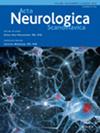Peroneal Electrical Transcutaneous Neuromodulation (Peroneal eTNM) in the Treatment of Essential Tremor
Abstract
Objectives
Given the limitations of the currently available treatment options for essential tremor (ET), the development of a safe and effective method to manage ET is warranted. The aim of this study is to investigate the safety and feasibility of peroneal electrical transcutaneous neuromodulation (peroneal eTNM) in patients with ET.
Methods
Patients enrolled in the study were treated with peroneal eTNM daily for 30 min over 6 weeks, followed by a 6-week follow-up period without stimulation. Peroneal eTNM was administered alongside their chronic medication.
Results
A total of 12 patients (eight men, mean age 60.2 ± 17.7 years, mean disease duration 9.2 ± 7.8 years) were enrolled. All patients were able to use the stimulation at home without assistance. During the study, only two transient treatment-related adverse events were reported. Seven patients (58.3%) reported subjective improvement using the Patient Global Impression of Improvement questionnaire at the end of treatment (EoT), and five patients (41.7%) reported improvement at the end of study (EoS). We observed a significant reduction in the total Essential Tremor Rating Assessment Scale (TETRAS) score, with median (IQR) values decreasing from 38.3 (30.5–49.0) at baseline to 36.5 (20.8–41.5) at EoT and 34.5 (13.0–36.8) at EoS. Similarly, tremor severity, as measured visually and with an accelerometer, showed significant improvement. However, no significant changes were observed in tools assessing quality of life and general disability.
Conclusion
This pilot study demonstrates that peroneal eTNM is safe and feasible for patients with ET. Despite the limited sample size, ET patients treated with peroneal eTNM showed significant improvement in tremor severity as measured by both subjective and objective tools. Future studies with a larger sample size and sham-controlled design are needed to confirm these findings and further validate the potential of peroneal eTNM in the treatment of patients with ET.
Trial Registration
ClinicalTrials.gov identifier: NTC06036368


 求助内容:
求助内容: 应助结果提醒方式:
应助结果提醒方式:


